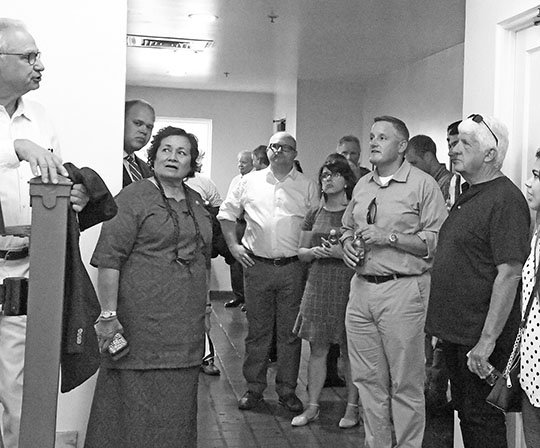Following an oversight hearing Monday, members of the House Committee on Natural Resources toured Bathhouse Row to see firsthand the National Park Service's historic leasing program at work.
"I'm hoping they'll get a sense about how we can adaptively reuse these historic structures in ways that meet our modern needs and still provide the kind of recreational and other experiences that our visitors want to have when they come here," said Hot Springs National Park Superintendent Laura Miller.
"So maybe the demand isn't to have 80 bath houses anymore, but the restaurants and the brewery, the new boutique hotel coming in, are all exciting ways to complement the bath houses that are remaining on the strip. We still have a lot of services available to our visitors, which is fantastic."
The tour began at Quapaw Baths & Spa where co-lessee Anthony Taylor shared some of the hurdles he and fellow architect Bob Kempkes faced more than 10 years ago when trying to turn their business venture into a reality on federal property.
"It was a couple of years of long process to understand what was going on before the field office in Omaha, Neb., really knew what we were trying to do here," Taylor said. "I have to say that the Park Service here worked very closely and very well with us."
He explained that a window currently looking out on the three thermal pools from the building's lobby was a remodel the state historic preservation office and the Department of the Interior did not want to approve initially, arguing that it would destroy the building's character.
"Our contention was we needed people to come in here and see what was going on back there to know what they were about to spend their money on," Taylor said. "Our park superintendent at the time, Josie Fernandez, I remember very well. I can almost quote her.
"She said 'You can either change with the times and allow these buildings to be reused in a modern way or you can have six or seven empty buildings on Bathhouse Row.' So they allowed us to do that."
Several of those who attended the day's events agreed the processes for allowing private entities to operate as lessees in the national parks is complicated and will need some streamlining.
"This is a kind of program, the kinds of programs that we need to emulate and I think the last statement that one of our staff said is 'How can we incentivize local land managers to become more active?'," said U.S. Rep. Rob Bishop, R-Utah District 1. "I just talked to the former superintendent that's here about some of the problems she faced and trying to go over roadblocks -- sometimes they were coming from the park service, sometimes from other entities, other agencies.
"We've got to encourage the park service in Washington, D.C., to say this is a program that we need to emulate, that we need to facilitate."
U.S. Rep. French Hill, R-District 2, said Hot Springs is a "model for the tenacity of the private sector from getting the National Park Service to be cooperative in putting our bath house back to productive use."
"As the testimony said, there are over 26,000 buildings in the National Park Service that are eligible, plus we have places inside the national Forest Service like at Lake Sylvia, Camp Ouachita, as well as the Corps of Engineers, so I took this as a way to build a standard way of best practices to speed the assets converted to a productive private use," he said.
The tour also included a stop at the Maurice Bath House, which is the final building on Bathhouse Row without any prospects for lease agreements. Miller said she hopes the committee takes away from seeing that structure not only the process, but the possibilities for leasing federal buildings.
"Even though these large historic buildings have a lot of needs as far as fixing the infrastructure, fixing the roofs, they're big buildings, they're old buildings and they're not cheap to restore," she said. "It's worth it in the end because they can live again and become something exciting and useful. As I think the businesses that are coming in now have demonstrated, I think whatever comes into the Maurice eventually will be equally as exciting and fun for our visitors' experience."
Local on 09/18/2018